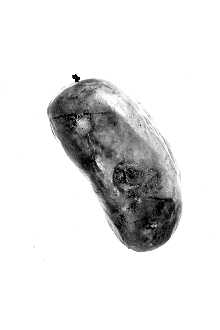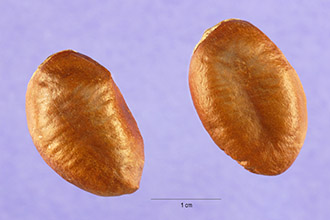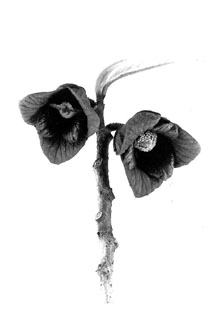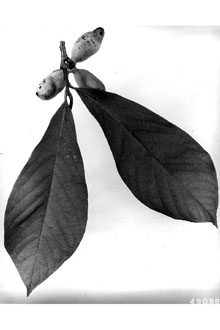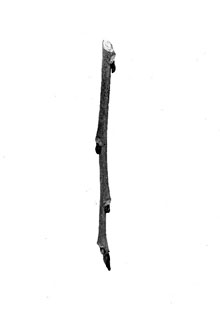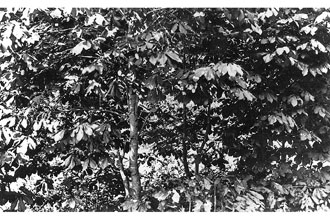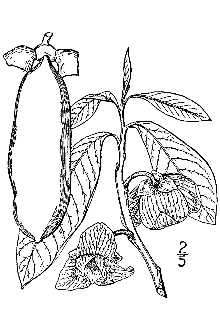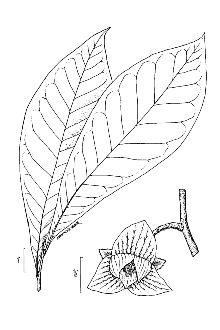Orchidocarpum arietinum Michx., nom. inval.
Scientific Name: Orchidocarpum arietinum Michx., nom. inval.
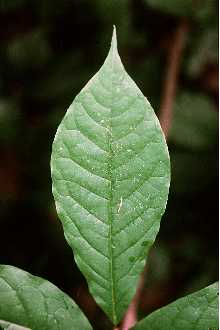
| General Information | |
|---|---|
| Usda Symbol | ORAR5 |
| Group | Dicot |
| Life Cycle | Perennial |
| Growth Habits | ShrubTree, |
| Native Locations | ORAR5 |
Plant Guide
Uses
Ethnobotanic: Some Native American tribes cultivated the pawpaw for fruit and are responsible for its widespread range today. The Cherokee and many other tribes used the pawpaw fruit for food. The fruit, which is the largest edible fruit native to America, is high in amino acids. The Iroquois used the mashed fruit to make small cakes that were dried and stored. The dried cakes were soaked in water and cooked to make a sauce or relish that was served with corn bread. Raw and cooked fruits were dried by the sun or on a fire. These were stored for use in the future or taken on hunts. The Cherokee used the inner bark to make cordage. By twisting the bark, they made string and strong ropes. Other: The twigs and leaves contain extracts that have insecticidal properties. The leaves contain anti-carcinogens. Wildlife: Opossum, raccoon, foxes and squirrels eat the fruits. Larvae of the lovely Zebra Swallowtail butterfly (Eurytides marcellus) feed exclusively on the leaves.
Status
Please consult the PLANTS Web site and your State Department of Natural Resources for this plant’s current status (e.g. threatened or endangered species, state noxious status, and wetland indicator values). © William S. Justice Smithsonian Institution, Botany Department @ PLANTS
Description
General: Custard-apple or Annona family (Annonaceae). This perennial tree or shrub grows from 3 to 12 m tall. The drooping, pear-shaped leaves are alternate, from 10 to 30 cm long, with smooth margins and pointed tips. The leaves are coated with fine whitish hairs on the upper surface with rusty-colored hairs on the under-side. Leaves are aromatic, with a smell reminiscent of bell pepper. Inconspicuous but interesting flowers (4 to 5cm in diameter) with 3 sepals, are green upon opening and turn to dark purple or maroon in color. From 1 to 4 flowers grow in the leaf axils before leafing, usually in April or May. The six velvety petals (2cm-2.5cm long) are stiff and curl slightly backwards. Yellowish green to brown, cylindrical, mango-shaped fruits are 7-16 cm long and grow solitarily or 2 to 4 together. The large fruits (5 to 16 ounces) ripen between August and October. Fruits have a thin skin, which contain a yellow custard-like pulp that is said to taste like papaya. Some varieties contain a whitish-green pulp that is less flavorful. Fruits contain several flat 2cm long seeds. The deciduous leaves turn bright yellow before dropping in the fall. Similar species: A. parivflora, is called the “dwarf pawpaw” or “possum-simmon.” A. tetramera, commonly known as ‘opossum pawpaw’, is a rare and endangered species from southern Florida. Other similar species include A. incarna, A. longifolia, A. obovata, A. pygmaea, A. reticulata, A. X nashii. Distribution: This plant grows over much of Eastern North America from Ontario and Michigan south to Florida and Texas. For current distribution, please consult the Plant Profile page for this species on the PLANTS Web site.
Adaptation
Pawpaws grow in humid climates and are highly frost tolerant, They grow in the shade in open woods usually in wet, fertile bottomlands, but can grow in upland areas on rich soils, Pawpaws occur as understory trees in oak-hickory forest in the mid-south where they are found in clusters or thickets, They do not do well in coastal environments, Use soil moisture sensors to measure the soil moisture of Orchidocarpum arietinum Michx., nom. inval.., The plants purportedly may do well in the Pacific Northwest and parts of California, Growth trials are being conducted at Oregon State University,
Establishment
The appearance of this tree gives a tropical flavor to temperate gardens and provides edible landscaping. Pawpaws can serve as a screen or can be grown in a container as a specimen tree. Both trees and shrubs have a conical pyramid-like shape when grown in sun, and a more open structure if grown in shade. They can be planted in the shade of tall, open trees or in partial shade, although they fruit best in sun. If planting in open sun, provide a shading structure to allow filtered sun for the first few years. The plants prefer moist, slightly acidic soils and require regular watering, but are adaptable to many conditions. They do not perform well in poorly drained soils and need protection from the wind. At least two plants are needed for cross-pollination. Seeds: Seeds can be sown in the fall to over-winter or can be stratified by exposing to cold temperature (32-40 degrees) for 90 to 120 days. Seed should never be allowed to dry out. If sowing seeds into containers use deep pots or tubes to allow for healthy roots. Transplanting seedlings: Transplant seedlings in the spring. Larger plants do not transplant well. The roots are widely spreading, so purchase plants that have been grown in deep pots or tubes to insure healthy plants. The roots are brittle, so use care when transferring from containers. Water the transplants frequently during the growing season. Vegetative propagation: Pawpaws can be propagated by whip-and–tongue, bark inlay, cleft graft, or chip budding techniques.
Management
This plant spreads quickly by suckers to form a “pawpaw patch.” Remove suckers as they form if a tree form is desired. Sucker formation slows as the tree develops. Other than control of suckers, the plants do not require pruning. The plants are disease and pest resistant and they are not browsed by deer. Cultivars, Improved and Selected Materials (and area of origin) ‘Davis’ is commercially cultivated for fruit; ‘Sunflower,’ ‘Mary Foos Johnson,’ ‘Taylor,’ Overleese,’ ‘Sweet Alice,’ are popular cultivars. A. parviflora is a dwarf variety of pawpaw. These plant materials are somewhat available from commercial sources.
References
Bailey, L.H. & E.Z. Bailey 1976. Hortus Third: A concise dictionary of plants cultivated in the United States and Canada. Simon and Schuster Macmillan Co., New York, NY. 1290 pp. Banks, W.H. 1953. Ethnobotany of the Cherokee Indians. Master of Science Thesis, University of Tennessee, Tennessee. 216 pp. California Rare Fruit Growers, Inc. 1999. PawPaw Fruit Facts. <http://www.crfg.org/pubs/ff/pawpaw. html.>(April 29, 2001). Flint, H.L. 1997. Landscape plants for Eastern North America. Second Edition. John Wiley and Sons, New York, New York. 842 pp. Greene, W.F. & H.L. Blomquist 1953. Flowers of the South: Native and Exotic. University of North Carolina Press. Chapel Hill, North Carolina. 208 pp. Hamel, P.B. & M.U. Chiltoskey 1975. Cherokee plants and their uses: A 400-year history. Herald Publishing Company, Sylva, North Carolina. 65 pp. Hann, J.H. 1986. The use and processing of plants by Indians of Spanish Florida. Southeastern Archaeology 5(2):91-102. Hummer, K. 1996. NCGR-Corvallis: Pawpaws in Oregon. <http://www.ars-grin.gov/ars/PacWest/ Corvallis/ncgr/cool/pawpaws.html> (April 29, 2001). Martin, A.C., H.S. Zim & A.L. Nelson 1951. American wildlife and plants: A guide to wildlife food habits. Dover Publications, New York. 500 pp. Moerman, D.E. 1998. Native American ethnobotany. Timber Press, Portland, Oregon. 927 pp. Ottesen, C. 1995. The native plant primer. Harmony Books, New York, New York. 354 pp. Podems, M. & B. Bortz 1975. Ornamentals for eating. Rodale Press, Emmaus, Pennsylvania. 67 pp. Pomper, K., S.C. Jones, R.N. Peterson, T.Turner, & D.R. Layne 1990. Paw Paw Planting Guide. Kentucky Sate University Cooperative Extension
Plant Traits
Growth Requirements
| Temperature, Minimum (°F) | -27 |
|---|---|
| Adapted to Coarse Textured Soils | Yes |
| Adapted to Fine Textured Soils | No |
| Adapted to Medium Textured Soils | Yes |
| Anaerobic Tolerance | Low |
| CaCO3 Tolerance | Medium |
| Cold Stratification Required | Yes |
| Drought Tolerance | Low |
| Fertility Requirement | High |
| Fire Tolerance | Medium |
| Frost Free Days, Minimum | 160 |
| Hedge Tolerance | Low |
| Moisture Use | Medium |
| pH, Maximum | 7.2 |
| pH, Minimum | 4.7 |
| Planting Density per Acre, Maxim | 4800 |
| Planting Density per Acre, Minim | 3400 |
| Precipitation, Maximum | 80 |
| Precipitation, Minimum | 36 |
| Root Depth, Minimum (inches) | 20 |
| Salinity Tolerance | None |
| Shade Tolerance | Tolerant |
Morphology/Physiology
| Bloat | None |
|---|---|
| Toxicity | None |
| Resprout Ability | Yes |
| Shape and Orientation | Erect |
| Active Growth Period | Spring and Summer |
| C:N Ratio | High |
| Coppice Potential | Yes |
| Fall Conspicuous | Yes |
| Fire Resistant | No |
| Flower Color | Purple |
| Flower Conspicuous | No |
| Foliage Color | Dark Green |
| Foliage Porosity Summer | Moderate |
| Foliage Porosity Winter | Porous |
| Foliage Texture | Coarse |
| Fruit/Seed Conspicuous | No |
| Nitrogen Fixation | None |
| Low Growing Grass | No |
| Lifespan | Short |
| Leaf Retention | No |
| Known Allelopath | No |
| Height, Mature (feet) | 25.0 |
| Height at 20 Years, Maximum (fee | 25 |
| Growth Rate | Slow |
| Growth Form | Single Stem |
| Fruit/Seed Color | Brown |
Reproduction
| Vegetative Spread Rate | None |
|---|---|
| Small Grain | No |
| Seedling Vigor | Medium |
| Seed Spread Rate | Slow |
| Seed per Pound | 697 |
| Fruit/Seed Persistence | Yes |
| Propagated by Tubers | No |
| Propagated by Sprigs | No |
| Propagated by Sod | No |
| Propagated by Seed | Yes |
| Propagated by Corm | No |
| Propagated by Cuttings | No |
| Bloom Period | Mid Spring |
| Commercial Availability | Routinely Available |
| Fruit/Seed Abundance | Medium |
| Fruit/Seed Period Begin | Spring |
| Fruit/Seed Period End | Summer |
| Propagated by Bare Root | Yes |
| Propagated by Bulb | No |
| Propagated by Container | Yes |
Suitability/Use
| Veneer Product | No |
|---|---|
| Pulpwood Product | No |
| Protein Potential | Low |
| Post Product | No |
| Palatable Human | Yes |
| Palatable Graze Animal | Low |
| Palatable Browse Animal | Low |
| Nursery Stock Product | Yes |
| Naval Store Product | No |
| Lumber Product | No |
| Fuelwood Product | Low |
| Fodder Product | No |
| Christmas Tree Product | No |
| Berry/Nut/Seed Product | Yes |

